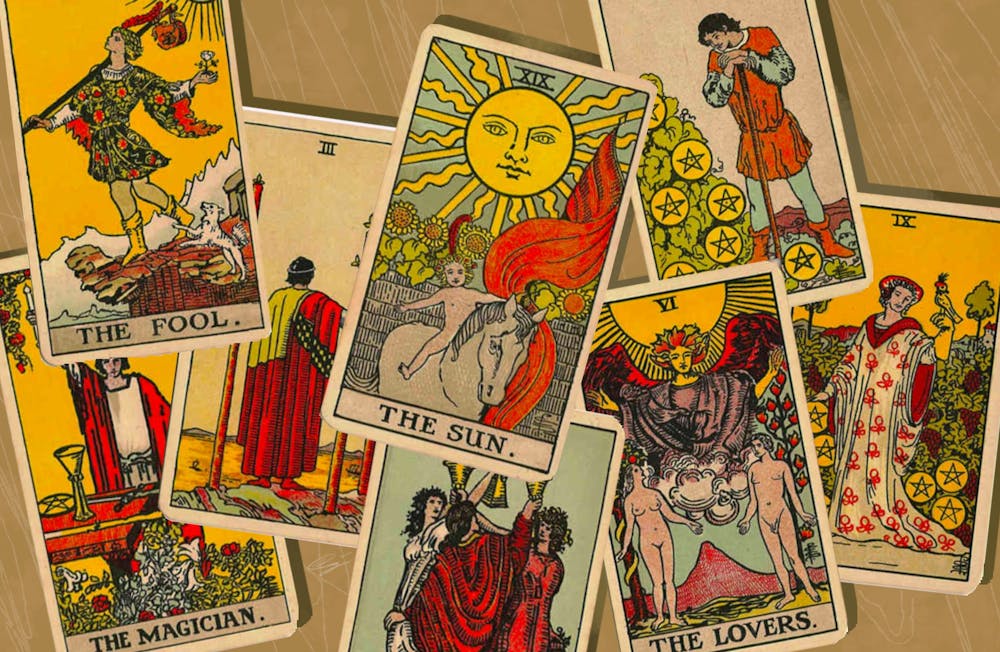On the rug of my dorm room, I set down a crystal of jagged purple amethyst and an opaque tower of selenite—a deck of tarot cards facing down in between them. When I conduct readings, I keep these two crystals on either side of the spread like guards: the amethyst, which is meant to bring one’s vibrations onto the attraction of life change, and the selenite, which is for clearing and neutralizing energy. With both present, the reading should both invite change while ensuring that it's safe. After circling my deck with some jasmine incense smoke, I hand the cards to the person I'm reading and ask them to shuffle.
I've been studying tarot for almost a year now. After finding cards in my household as a kid, either buried underneath photo albums or piled next to Ganesha elephants on a windowsill, I finally began practicing with a Rider–Waite tarot deck—the first illustrated edition to become mainstream for readers to buy in 1909. To me, and according to Advanced Tarot by Paul Fenton–Smith, tarot isn't about predicting the future; it's about a higher understanding of the present to inform the future. This awareness of the present is reflected in the art of the cards.
In the rush to TikTok as refuge from the COVID–19 pandemic, tarot readings fit perfectly into our collective need for guidance. The hashtags “#tarotreading” and “#tarot” have accumulated over one billion views combined on TikTok. Whether it be pulling the first letter of your soulmate from a jar or the classic “use this sound” to get a text back, tarot is a meaningful element of the app. Because of the app’s algorithm for curating For You pages, many people interpret the arrival of a tarot reading on their feed as intended for them regardless of its impersonal nature. From this, new decks and designs have flourished in the past two years.
In tarot, interpretation derives from the visual symbolism, from the number of yellow drops underneath The Moon card in the 18th century to the fishnet and sneakers in The Hanged One of Lisa Sterel’s 2020 deck, The Modern Witch. Surprisingly, this intricate artistic system of analysis didn't originate with mystical intention, but with simply the drawings on playing cards.
In the way that spades, hearts, diamonds, and clubs are the groups we associate with playing cards, in 15th century Italy, cups, swords, batons, and coins were their own categories that are now known as the Minor Arcana. Alongside these subsets were the “trump cards,” ones that would become bedroom tapestries of The Lovers or phone cases of The Fool, which are the Major Arcana. Quickly, the game of “tarocchi appropriati” migrated from Italian aristocracy into other regions of Europe—a timeline that can be told through the characters and stories on the cards themselves.
From medieval scepters and stained–glass backgrounds in the 1500s, tarot imagery gradually evolved into wooden wands and abstract nature scenes. Tarot’s increasing use in religious contexts inspired more diverse, yet more specific designs. When tarot arrived in France, numerous French teachers and occultists published their theories of tarot holding ancient Egyptian meaning. They saw the cards as a form of hieroglyphics and claimed that their language came from Thoth, the god of wisdom. Since then, tarot went from a game of themed images meant for stories and poems to a mystical voice of guidance through art.
One of the most unusual trends in tarot cards is how they welcome different cultures and styles of representation. In my own search for decks, I’ve encountered comedic ones from The Philly Phanatic as The Fool in the Philly Tarot Deck by James Boyle to more inclusive themes, like two men holding one another in The Lovers in the Star Spinner Deck (Trung Le Nguyen). In all spiritualism, the only way to channel full belief is to put our whole selves into it. Biblical references to Adam and Eve or European royalty are not relevant to generations experimenting with tarot now. Through the landscape of art, tarot is an untethered practice that anyone can use to call upon the divine forces of the world.
When I came to college, I liked to joke that my tarot cards were showing “Penn face.” All of the readings I'd done over the summer with friends were visibly emotional, full of The Cups, which refer to internal feelings. However, during orientation, I noticed an influx of pentacles and swords, both of which represent more intellectual and money–oriented subjects. Because of this, tarot has been a transformative partner to me in trying to shed the tendency to ignore what we are feeling—it's a voice that reminds me of all the things I know to be true but won’t tell myself.
At the end of a reading, I return all of the cards to their families, meaning they go back in numerical and symbolic order. I put them in a cloth bag and let them wait on my altar for the next reading. Whether it be your own process or the TarotTok account you follow, each has their own ritual and relationship to the tiny colors and sketches on a card. And just like the art, it'll be different each time one falls out of the deck.

